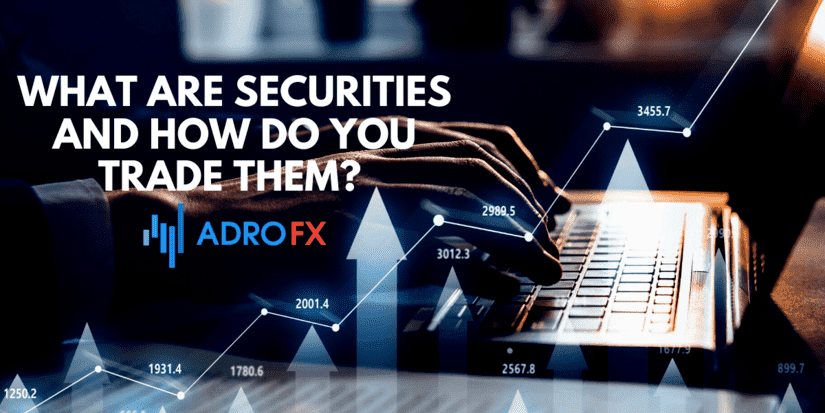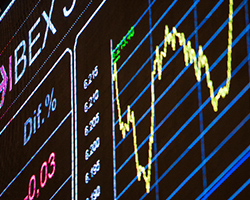What are securities and how do you trade them? - Guide 2021

Securities are a type of investment, usually not available to the general public, as this market is quite challenging to research. The most common examples of securities are stocks and bonds.
However, there are many more types of securities, and each has its characteristics and risks. Investors, especially beginners, need to understand it if they expect a good return on invested funds.
Let's look at the most common categories and types of securities and how they work.
What are securities in finance?
Security is a document that confirms various rights of the owner. Mainly, it is the right to fulfill property obligations - to receive part of the company's earnings, the return of borrowed funds, and so on. But not only. It can also be a right to participate in the company's affairs -like shareholders' meetings. Owning the security, you can exercise your rights (for example, to receive dividends or vote at shareholders` meetings) or transfer them to another owner (to sell or assign them).
What are securities - Different types explained
There are several types of securities. Let us have a look at them so we get a clearer picture of securities trading.
1. What are equity securities?
Equity securities are a type of financial instrument that entitles an investor to a stake in a company commensurate with the percentage of shares he owns. For example, if someone owns shares of the issuer's stock, it means that they are the company's equity property.
In other words, the holder claims a percentage of the issuer's income and assets. For example, owning 1% of the total number of shares, equity ownership of the company is also equivalent to 1%.
Equity securities usually earn regular returns to shareholders in the form of dividends. The share price rises or falls depending on the financial markets and the state of the company. The advantage of this type of investment is that gains, as well as losses, are commensurate with ownership.
2. What are debt securities?
Every business needs capital to grow. Companies first go to banks, but banks don't take on too much risk and limit lending. Then the business enters the capital market by issuing debt securities.
Debt securities allow a company to raise capital by borrowing from the public. They typically entitle the holder to regular interest rate payments and repayment - the return of a fixed amount.
At maturity, the debt is repurchased by the issuer. There are also other contractual rights of the bondholder, which, however, do not include the right to vote.
There are different debt instruments, such as government and corporate bonds, certificates of deposit, secured securities, bills of exchange, and checks. These securities differ in maturity, collateral, and other characteristics.
All debt securities are agreements between two parties - the issuer and the creditor. It makes it essentially different from equity securities: while debt holders are creditors of the company, shareholders are its owners.
3. What are fixed-income securities?
Another class of debt instruments increasingly used in socially transformative investing are fixed-income securities. These are essentially large loans with significant maturities and are typically issued by underwriters or investment banks, which offer them to a variety of investors, including pension funds, insurance companies, and high net worth individuals. Because of their volume and very indirect marketing, fixed-income securities usually go through a complex rating process before being offered to investors. Financing through fixed-income securities is a huge component of global capital markets. Therefore, such securities can attract substantial capital for serious undertakings.
The most common type of fixed-income securities are long-term bonds, but shorter-term notes are also used{. Borrowers who raise financing with fixed-income securities commit to paying the bondholders the principal on predetermined maturity date and to paying interest - called coupon income - at regular intervals over the life of the bond. The bondholders, in turn, can sell the bonds to other investors at their discretion at a price that varies depending on the ratio of the income interest rate to prevailing interest rates in the market.
Because of their volume and complexity, fixed-income securities are most often used by very mature institutions with stable yield streams capable of covering coupon payments. Among socially-oriented organizations, universities and hospitals are the most active in using this instrument - in the U.S. they often use credit risk mitigation in the form of tax deductions for the number of coupon payments received by investors.
4. What are mortgage-backed securities?

A mortgage-backed security is a bond issued by a bank and secured by its customers' payments on mortgage loans.
In simplified terms, such a bond is formed as follows: the bank issues mortgages to customers, which are combined into a common pool (mortgage coverage), and then the rights to receive payments from this pool are structured, and security is issued against them. Thus, the holder of this security receives a yield secured by the mortgage payments. This security is called a mortgage bond, and the process of reselling the debt as securities is called securitization.
For a bank, the issuance of mortgage-backed security allows it to lock in an income that is generated by the difference between the mortgage rate it receives and the coupon paid on the bond. The proceeds from the sale of bonds can be used again to issue new loans. Thus, the credit institution can increase its asset turnover and improve earnings potential.
For the investor, mortgage security is a long-term investment, which is secured by real estate. Even if the borrower stops paying the mortgage, the bank can sell his apartment at auction and fulfill its obligations to investors. The yield on such securities, as a rule, is somewhat higher than on issues of comparable credit quality.
The downside for the investor is the uncertainty of future payment streams on the bond. Borrowers may prepay their mortgage debt, resulting in an unplanned prepayment of a portion of the security's principal (amortization). Thus, the investor is exposed to the risk of reinvesting the amortized amount. It could lead to higher transaction costs as well as lower yields if interest rates fall.
5. What are marketable securities?
Marketable securities are a type of financial asset that can be freely traded on markets. Many assets can be classified as marketable securities: stocks of companies (listed or unlisted), bonds, some forms of collateralized debt, and derivatives (futures, options, swaps). Marketable securities are intended for resale to third parties. The main purpose of their issuance is to cover budget deficits and create liquid assets for commercial enterprises. Most of these securities are held by a relatively small number of dealers. The dealers are branches of major commercial banks, financial-industrial corporations, and firms specializing in buying and selling federal government securities. Dealers trade primarily with holding banks, insurance companies, corporations, pension funds, foreign firms, and foreign commercial and central banks.
What drives the price of a security?
The price of a security on a stock exchange is determined by supply and demand. Take stocks, for example. Supply is formed by those who want to sell stocks, and demand is formed by those who want to buy them. The supply and demand ratio is influenced by several factors:
- The financial condition of the company. Supply and demand explain why stock prices fluctuate. But what makes investors decide to buy or sell at existing prices? First, they need to know the financial condition of the company. If it has announced low earnings, the price of its securities is likely to fall. In addition to knowing past performance, they also need to understand what the future holds for the company. A company's low earnings do not always mean that it is in dire straits. It may have spent a lot of funds on improving production, developing new products and services, etc. In this case, the company can expect substantial returns in the future.
- Industry analysis. Another important thing that affects price movements is the general state of the industry in which the company operates. A company's stock prices can rise or fall depending on how investors view the state of the industry, namely whether the industry is growing or stagnant. For example, the financial condition of the company is excellent, but the development of the industry has slowed down. In this situation, an investor may wonder how long the company will be able to maintain growth when the industry as a whole is slowing down. In this case, the price of the company's securities may decline.
- Economic rate. In addition to events surrounding each industry or company, analysts closely examine economic indicators such as gross domestic product (GDP), inflation rates, interest rates, unemployment, trade balances, and budget deficits/surpluses. For example, when interest rates go up, people, businesses, and the government must pay more for loans. It means that a company can postpone getting a loan for a new project.
- Another measure of economic development is the consumer price index, which reflects the "cost of living. If prices go up, life gets more expensive, people spend more capital on their minimum needs and less on investments, which is bad news for the economy. When economic indicators go up, and the economy improves, companies strive, the future looks promising, and people have more funds for equity securities. When that happens, stock prices begin to rise, which in professional parlance is described as a " bullish market." Conversely, when the economic situation worsens, stock prices start falling.
How to start trading securities?

To take part in equity securities trading you need, apart from having free funds, at least a basic knowledge of economics and the rules of the stock exchange. At the first stage, you should get it from special literature - there is no way without it, at the second stage you need to choose a brokerage firm and open an account in it. And only at the third stage, having accumulated the experience of victories and defeats, the luggage of knowledge, and a sufficient amount of free finances, you can try to trade on your own.
Learning to trade in the stock market consists of the following stages:
- Reading of the table of quotes, in which several prices and volumes of transactions are presented for each type of equity securities:
- The opening price of the exchange session.
- The maximum price.
- The minimum price.
- The closing price of the exchange session.
- Daily turnover in the number of securities.
- Reading charts, which are a graphical reflection of tabular data, but are of different types and can be electronically adjusted to any interval - from one day to a full period of quotes of particular equity security on the exchange. Usually, charts reflect data in the form of vertical "bars" or "Japanese candlesticks".
- Understanding stock indices. Stock indices help brokers and investors obtain information not only on given equity security but also on the overall securities market. Stock indices are aggregated indices of price movement of the chosen securities set. At the moment there are about 2500 stock indices in the world), but you should pay attention to the main ones, like S&P or Dow Jones.
- Mastering the basics of financial mathematics, which involves being able to independently calculate gains, losses, relative amounts of gains and losses, gainfullness and loss. It is necessary to obtain a more or less objective, independent from the time of the trade, idea of its reliability and to compare different trades by objective indices.
Undoubtedly, it is preferable not to start from 0, but to start with some education or follow some analytical sources, so that in the first stage you can better understand how the securities market functions. In any case, if you have decided to participate in the equity securities trading, you have to use the services of brokerage firms, which serve legal entities and individuals in the securities market, executing their orders for transactions with securities.
After choosing the brokerage company and opening a trading account to start buying and selling equity securities, you will need to install on your computer or smartphone a special software, which will be provided by the broker - the trading platform. Exactly through this program, it is possible to make transactions with securities in real-time. As a rule, all modern programs of this type are simple, convenient, and intuitive, so no technical difficulties should arise.
Securities analysis

As it is well-known, the purpose of any analysis is to predict the future price behavior of particular security as accurately as possible. Without analysis, investors and traders will blindly buy and sell securities, unaware of what is happening in the market. The most promising issuing companies may eventually fail. On the other hand, small and unsightly companies can quickly and unexpectedly turn into behemoths whose shares rise in value at an enormous rate. All market players analyze securities to have an idea of who is doing what in the market, which companies are developing and which are stagnating, in which equity securities one should invest and which ones should be sold.
Depending on how you perceive the market, you may belong to technical, fundamental, or mixed analysts. Fundamental analysis of a security is based on macro and microeconomic, demographic, environmental, financial, and even psychological factors affecting the equity securities price. Fundamental analysts follow the news, rely heavily on information, and may look for "insider" forecasts (i.e., illegal distribution of confidential information outside the company). The technical analyst likes to work exclusively with a price. He firmly believes that the price has already taken absolutely everything into account. From the perspective of a technical analyst, price is the result of a supply/demand struggle, and what happens before that (i.e., for what reason people buy and sell) is unimportant. Technical analysts are only guided by charts, although any analyst also uses them under convenience.
If you are going to earn on daily speculations, intraday trading on the stock market (day-trading), you will more often require methods of technical analysis. If you are investing for the long term, then you need to put aside the current turmoil and turn to fundamental analysis, which allows you to get to the root.
Each method of securities analysis has advantages and disadvantages. After trying both methods, analysts usually settle on one and go all the way with it. But it is important to remember that it is best to use the best of each method of securities analysis. Take the best of both technical and fundamental analysis, succeeding in both. Don't get hung up on one thing, be creative but diligent.
Conclusion
With the right approach, securities are a good way for investors to earn a substantial income by lending it to companies and governments. Buying a stock or bond is a vote for that company's future growth.
Securities put capital into the economy, helping both the investor and the issuer. But the irony is that investors, especially beginners, invest in securities without understanding their classification. And as a consequence, unsuccessful or even failed investments. You must agree that this is a weighty reason to know the types of securities and how they work.
About AdroFx
Being a well-established brokerage company, AdroFx offers the best trading conditions to its clients from 200 countries. Founded by experts with a couple of decades of the overall experience, AdroFx is one of the best platforms on the market for shares trading. Either a newbie or experienced trader, both will find here what they are looking for since the company provides various trading accounts for different trading styles and goals.









